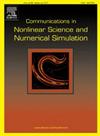The control for multiple kinds of solitons generated in the nonlinear fractional Schrödinger optical system based on Hermite-Gaussian beams
IF 3.4
2区 数学
Q1 MATHEMATICS, APPLIED
Communications in Nonlinear Science and Numerical Simulation
Pub Date : 2024-09-27
DOI:10.1016/j.cnsns.2024.108375
引用次数: 0
Abstract
In this paper, we investigate the control for Hermite-Gaussian (HG) solitons in the nonlinear fractional Schrödinger equation (FSE) by sequentially applying power function modulations, cosine modulations, parabolic potentials, and quadratic phase modulations (QPM). In the photorefractive media, the HG beam forms scattered breathing solitons when the fractional diffraction effect equilibrates with nonlinear effect. Under the power function modulation, the soliton maintains an equidistant linear transmission along the z-axis, and the number of solitons is equal to the mode. In the cosine modulation, the soliton distorts and its energy rapidly decreases after a certain distance of transmission. The time of the distortion varies with the Lévy index, photorefractive coefficient, modulation frequency and order. The freak spots exhibit a “flower” shape pattern. If a parabolic potential is introduced, the HG beam forms crawling soliton pairs or merges into a single bounded breathing soliton by adjusting the correlation among the Lévy index, nonlinear and parabolic coefficients. By increasing the nonlinear coefficient in the negative QPM regime, the defocusing HG beam emits several “filiform” breathing solitons during its propagation, which move in a parallel straight line to each other. The HG beam is transformed into a single fine breathing soliton after being focused under a positive QPM. The time of the formation and breathing rate varies with the Lévy index, QPM and nonlinear coefficients. Moreover, the number of solitons changes irregularly with modes. These results are significant for applications in optical communication, optical device design, and optical signal processing.
基于赫米特-高斯光束的非线性分数薛定谔光学系统中产生的多种孤子的控制
本文研究了在非线性分数薛定谔方程(FSE)中,通过依次应用幂函数调制、余弦调制、抛物势和二次相位调制(QPM)来控制赫米特-高斯(HG)孤子的问题。在光折射介质中,当分数衍射效应与非线性效应达到平衡时,HG 光束会形成散射呼吸孤子。在幂函数调制下,孤子沿 Z 轴保持等距线性传输,孤子数等于模式数。在余弦调制下,孤子会发生畸变,在传输一定距离后能量会迅速下降。畸变的时间随列维指数、光折射系数、调制频率和阶次而变化。畸变光斑呈现出 "花 "形图案。如果引入抛物线势能,HG 光束会形成爬行孤子对,或通过调整莱维指数、非线性系数和抛物线系数之间的相关性合并成一个有界呼吸孤子。通过增加负 QPM 状态下的非线性系数,散焦的 HG 光束在传播过程中会发射出多个 "丝状 "呼吸孤子,这些呼吸孤子相互平行直线运动。在正 QPM 条件下聚焦后,HG 光束会转化为单个精细呼吸孤子。形成时间和呼吸速率随列维指数、QPM 和非线性系数的变化而变化。此外,孤子的数量随模式的变化而不规则变化。这些结果对于光通信、光学设备设计和光信号处理等领域的应用具有重要意义。
本文章由计算机程序翻译,如有差异,请以英文原文为准。
求助全文
约1分钟内获得全文
求助全文
来源期刊

Communications in Nonlinear Science and Numerical Simulation
MATHEMATICS, APPLIED-MATHEMATICS, INTERDISCIPLINARY APPLICATIONS
CiteScore
6.80
自引率
7.70%
发文量
378
审稿时长
78 days
期刊介绍:
The journal publishes original research findings on experimental observation, mathematical modeling, theoretical analysis and numerical simulation, for more accurate description, better prediction or novel application, of nonlinear phenomena in science and engineering. It offers a venue for researchers to make rapid exchange of ideas and techniques in nonlinear science and complexity.
The submission of manuscripts with cross-disciplinary approaches in nonlinear science and complexity is particularly encouraged.
Topics of interest:
Nonlinear differential or delay equations, Lie group analysis and asymptotic methods, Discontinuous systems, Fractals, Fractional calculus and dynamics, Nonlinear effects in quantum mechanics, Nonlinear stochastic processes, Experimental nonlinear science, Time-series and signal analysis, Computational methods and simulations in nonlinear science and engineering, Control of dynamical systems, Synchronization, Lyapunov analysis, High-dimensional chaos and turbulence, Chaos in Hamiltonian systems, Integrable systems and solitons, Collective behavior in many-body systems, Biological physics and networks, Nonlinear mechanical systems, Complex systems and complexity.
No length limitation for contributions is set, but only concisely written manuscripts are published. Brief papers are published on the basis of Rapid Communications. Discussions of previously published papers are welcome.
 求助内容:
求助内容: 应助结果提醒方式:
应助结果提醒方式:


